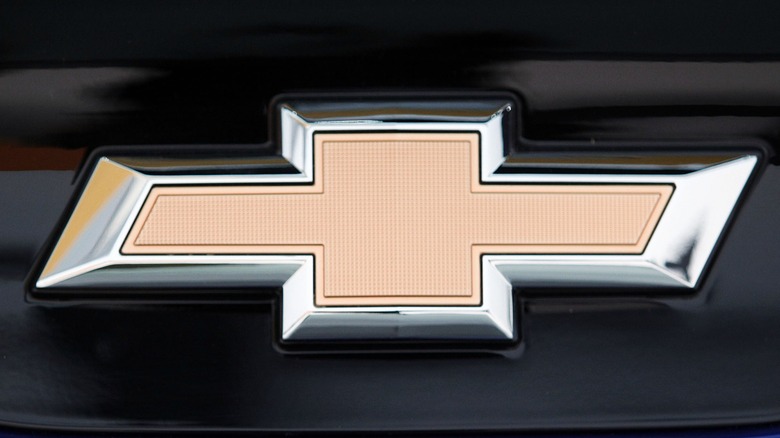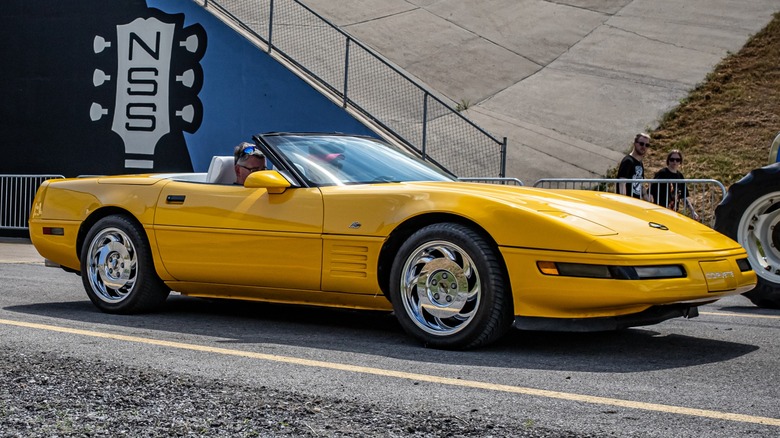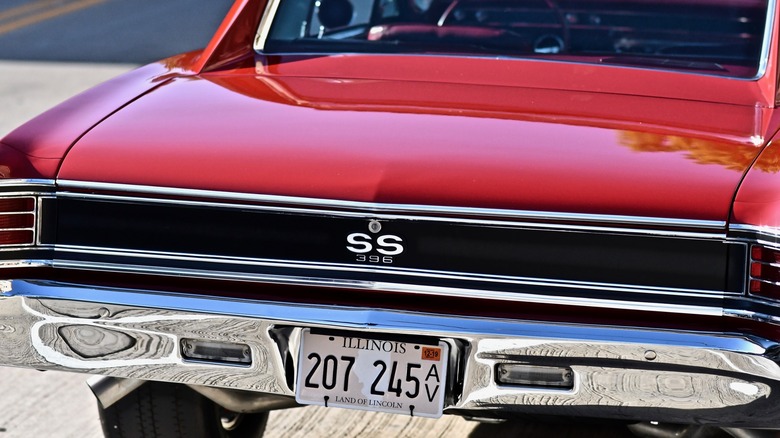6 Of The Most Reliable Engines Ever Made By Chevrolet
Over the last 112 years, Chevrolet's lineup of production automobile engines has evolved. Chevrolet's first engine was the 40-horsepower 299-cubic-inch six-cylinder that powered the 1911 Chevrolet Classic Six. As Chevrolet's first production engine, the 299 propelled the Classic Six, a five-passenger touring sedan, from zero to 50 mph in 15 seconds and to a 65 mph top speed.
Chevrolet introduced its "bowtie" logo in 1914, along with its first four-cylinder engines. While the 1911–1914 Classic Six Chevrolets were too expensive for many people's budgets, the four-cylinder H-Series Royal Mail roadster and Baby Grand touring car models sold for less than half of the Classic Six price.
The 1914 Chevrolet four-cylinder was the first Chevy engine with intake and exhaust valves built into the cylinder heads. The early overhead-valve four-cylinder Chevrolet engine displaced 171 cubic inches and generated 24 horsepower. Chevrolet continued using the H-Series' four-cylinder design through 1928 due to its cost-effective reliability.
Those were only the beginning. Over the next century, Chevrolet continued to build its reputation with reliable engines like these.
The Gen I 350-cubic-inch small-block V8
Introduced in 1955, the first generation Chevrolet small-block V8 became the foundation for engine variations that have powered Chevrolet vehicles for eight decades. While the 350-cubic-inch version wasn't the first, it's one of the most popular and reliable small-block V8 engines ever produced by Chevrolet.
The first Chevrolet small-block (SBC) 350 V8 debuted in the 1967 Camaro. Over the following years, Chevrolet installed the first-generation SBC 350 in a wide range of automobiles in its lineup, including sports cars, pickup trucks, family sedans, and SUVs. The Gen I SBC 350 found homes in various Chevrolet cars and trucks until 1992, when Chevrolet introduced the slightly revised Gen II LT1 350.
The 350 used the same small-block design and four-inch cylinder bores as the previous 327-cubic-inch V8, with a longer 3.48-inch crankshaft stroke compared to the 327's 3.25-inch stroke. Early carbureted versions gave way to throttle body injection after 1988, reducing cold morning starting issues. Considering its many years of service, Gear Head Engines calls it "one of the most reliable engines ever."
Gen II LT1 5.7-liter V8
Following the same basic design and dimensions as the previous generation SBC 350, the Gen II LT1 5.7-liter V8 also displaced 350 cubic inches. It debuted in the 1992 Chevrolet Corvette, capable of reaching a top speed of 176 mph and covering a quarter mile in 12.8 seconds at 111 mph.
The Gen II LT1 powered various GM cars and trucks until 1997. LT1 engines destined for use in Corvettes and Camaros received aluminum cylinder heads on cast iron blocks, while all other applications featured full cast iron construction.
While Chevrolet used the LT-1 moniker with a version of its Gen I small block, the Gen II LT1 features some refinements over its predecessor. The naming similarity is a little confusing, but the hyphen in the early LT-1 name differentiates it from the newer LT1.
The 5.7-liter LT1 featured a 10.4:1 compression ratio, with a rated output of 300 horsepower and 330 lb-ft of torque. Te new reverse-flow cooling system sent engine coolant from the radiator to the cylinder heads before flowing through the rest of the engine, allowing a higher compression ratio over the Gen I SBC's 9.5:1. Cooler cylinder temperatures allowed fuel to burn evenly at higher compression without damaging detonation or spark knock.
Gen III 5.3-liter V8 Vortec 5300
Chevrolet introduced the 5.3-liter Vortec 5300 as part of its third-generation SBC in 1999 and continued its use through 2007, where it overlapped with the Gen IV version for a few model years. Gen IV, introduced in 2005, and Gen V, introduced in 2013, Vortec 5300 variants are still in production. However, since the original Gen III Vortec 5300 engine has the best reputation for reliability, we'll focus on it.
The Gen III Vortec 5300 uses a 3.78-inch cylinder bore and 3.622-inch crankshaft stroke to achieve its 5.3-liter or 325 cubic-inch displacement. While the four variations, LM7, LM4, L33, and L59, all have aluminum cylinder heads, the LM7 and Flex-Fuel L59 variants used cast iron engine blocks, and the LM4 and High-Output L33 variants featured lighter-weight aluminum block construction.
All four Gen III Vortec 5300 variants provide excellent reliability. Vehicle History reports that Chevrolet pickups and SUVs with these engines routinely exceed 200,000 miles and are often available "for around $5,000."
Chevrolet 427 cubic inch LS7
Chevrolet developed the 505-horsepower 427.6-cubic-inch LS7 based on its fourth-generation small block design to propel the returning Z06 Corvette from zero to 60 mph in 3.4 seconds. While 2006 to 2013 Z06 Corvettes were primary recipients of the all-new LS7, it also powered Z28 Camaros in 2014 and 2015.
Squeezing 427 cubic inches from a small block is no easy task. With its limited 4.40-inch spacing between cylinder centers, the LS7's 4.125-inch cylinder bores only leave 0.275-inch between its cylinders. To maintain proper cylinder wall thickness, Chevrolet cast the exterior cylinder walls without any separation between them.
To achieve its 427.6 cubic inches, the LS7 uses a forged steel crankshaft with a 4.0-inch stroke to compliment the 4.125-inch Siamese-bored cylinder configuration. The crankshaft rides in forged steel main bearing caps attached to the aluminum block with six bolts each, and connects to hypereutectic aluminum pistons via forged titanium connecting rods.
The LS7's quality components and precision construction resulted in superb reliability. New Parts says that apart from a cylinder head machining issue involving valve guides and seats that Chevrolet addressed under warranty, the LS7 is "known to be quite reliable."
The Chevrolet Mark IV 396 cubic inch big block
Chevrolet learned many lessons during its first foray into big block engine manufacturing with its W-series big blocks. The W-series, with displacements including 348, 409, and 427 cubic inches, powered full-size Chevy cars and trucks from 1958 until the new Mark IV engine design replaced it in the mid-1960s.
The 396 was the first iteration of the Mark IV design, and its sub-400-cubic-inch displacement allowed Chevrolet engineers to use it in the automaker's mid-size and sports cars, including Chevelles and Camaros. At the time, an internal General Motors edict prevented engineers from placing larger engines in anything besides its full-size lineup, except for Corvette engineers, who could do almost anything they wanted.
Chevrolet made the first production Mark IV 396 available in the 1965 Corvette and Chevelle. The first 396 engines used in the Corvette, dubbed L78 TurboJets, could propel the 1965 Stingray through the quarter mile in 14 seconds, crossing the finish at 104 mph. While Chevrolet listed the L78 396 horsepower at 425, the less expensive Chevelle's nearly identical L37 396 was rated at 375 horsepower. Driving Line suggests the large difference between the two versions would be closer, except Chevrolet intentionally lowered the L37's rating by recording horsepower at 5,600 rpm compared to the L78's 6,400 rpm.
Duramax 6.6-liter V8 turbo-diesel
Chevrolet truck owners often desire maximum pulling power from their pickup trucks. When they do, they turn to the Duramax 6.6-liter V8 turbo-diesel, which, in its current form, provides 910 lb-ft of torque and 445 horsepower. Paired with the Allison ten-speed transmission, towing large campers, livestock trailers, and heavy equipment is a breeze.
General Motors developed the Duramax turbo-diesel in partnership with Isuzu Motors during the late 1990s, hoping to take advantage of Isuzu's diesel engine knowledge and capture a larger share of the heavy-duty pickup truck market. The plan worked as the new Duramax was "the first high-pressure common-rail, direct-injection powerplant to hit the U.S. vehicle market," according to MotorTrend. Dodge and Ford would follow GM's lead over the next couple of years with their Cummins and Power Stroke diesel engines.
Chevrolet began using the Duramax diesel engine in its diesel-powered Silverado lineup in 2001, but early versions had problems surrounding injector lifespan. The most reliable Duramax versions include the L5P manufactured from 2017 to 2023 and the pre-emissions-mandate 2006 to 2007 LBZ. Even the original LB7 Duramax engines produced from 2001 to 2004 prove reliable after replacing the injectors with newer, improved versions.
Why did we choose to highlight these Chevrolet engines?
While there are other Chevrolet engines that offer excellent reliability, we chose this group of long-lived Chevy engines to represent a variety of applications that include sports cars, family SUVs, and heavy-duty pickup trucks. Each of the listed engine models is proven to stand the test of time and deliver trouble-free performance for hundreds of thousands of miles.
In addition, in most cases, the engine model selected represents a milestone in manufacturing technique, performance advancement, or technology in the evolution of Chevrolet engines. While newer isn't always better, it's evident that advancements in materials and precision manufacturing are leading to more powerful, highly efficient, longer-lasting Chevrolet engines.







